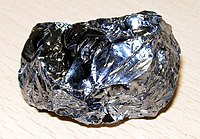
Photo from wikipedia
Zirconium (Zr)-based alloys are commonly used in the nuclear industry for a variety of applications, such as nuclear reactor fuel cladding in pressurized water reactors, and as a hydrogen isotope… Click to show full abstract
Zirconium (Zr)-based alloys are commonly used in the nuclear industry for a variety of applications, such as nuclear reactor fuel cladding in pressurized water reactors, and as a hydrogen isotope absorbing material in tritium producing burnable absorber rods (TPBARs). Zr alloys are widely used in such applications due to their favorable mechanical behavior (e.g. yield strength, fracture toughness, creep, etc.), corrosion resistance, and low thermal neutron cross-section [1]. Despite these many desirable properties, corrosion of Zr alloys can limit component lifetime. A better understanding of oxide formation mechanisms and kinetics could thus enable improved alloy design and predictive capabilities related to fuel assembly degradation, such in a reactor operating environment, in spent fuel storage pools, or during an accident scenario (e.g. Fukushima-Dai Ichi, Three Mile Island, and Chernobyl).
Journal Title: Microscopy and Microanalysis
Year Published: 2019
Link to full text (if available)
Share on Social Media: Sign Up to like & get
recommendations!